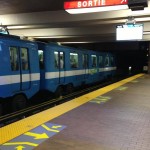- Never be afraid to try public transportation when you visit a new city.
- Toronto’s Union Station
- Micki’s feet.
By Micheline Maynard
Last week, I set off for Canada to do research for the upcoming Curbing Cars book. I decided before I left that I’d try to get around without a car.
You might think that’s a reasonable idea, since Toronto and Montreal have extensive public transit systems. I’ve lived in big cities, after all, such as Tokyo and New York, where I didn’t have a car.
But I usually drive to Toronto, or get a rental car while I’m there. And, because I wanted to see different parts of Montreal, I originally planned to rent a ZipCar for a few hours, only to find the service isn’t offered there.
Instead, I wound up using every kind of non-personal car transportation available to me. It was an experience that taught me how difficult it can be to adjust to living car free, once you’re used to jumping behind the wheel. But many people get along that way. In fact, the number of car free families rose in the U.S. last year for the first time in a half century.
Here’s how my trip went.
I took Via Rail from Windsor, Ontario, just across the border from Detroit, to Toronto, on to Montreal and back to Windsor. (There was a mishap on the return trip, but we’ll save that for a later story.)
In Toronto, I relied on the subway, streetcars, buses, a couple of taxis, and my own two feet. Once I got to Montreal, I used its Metro, the bus system, walking and took taxis to one restaurant and to the train station. I also checked out the Bixi bike sharing system. While Toronto has one, I actually never came across a docking station.
If I had packed a little lighter, I could have easily used the subway in both cities to get from the station to my hotel, but I decided to treat myself to taxis in both cities. Although I’ve been a visitor a number of times, and I thought I knew my way around, there were some obstacles.
You need to know how to read a map. In an era when we rely on GPS systems and apps to tell us everything, taking public transportation requires map-reading expertise. Apps can tell you which trains to take, and what time the bus will arrive, but they don’t necessarily tell you where to go once you’re above ground. You still need to be able to read those maps inside the subway stations, or the map on your mobile phone. If you are directionally challenged, or just rusty, as I was, it takes some time to adjust.
It’s easy to get turned around. My mom has always said I had a brain like a homing pigeon, because of my ability to figure out the right direction to take. Well, when you learn cities from behind the wheel, and you don’t have your navigation system telling you to “take the next right,” you can easily get lost. I went the wrong way on major streets in both Toronto and Montreal. I wound up on Queen East in Toronto when I needed Queen West, and I was on Sherbrooke East when I intended to take it west.
In both cases, I had to change my itinerary because there would not be enough time to go back and make it to my next appointment. Luckily for me, both Toronto and Montreal have espresso bars where you can spend a few minutes getting reoriented. (Maybe I should have had a hit of caffeine before I set out, not after.)
There are other people sharing your ride. When you’re used to driving or walking, you discover something very quickly: there are lots of people going in the same direction that you’re going. The privacy you get when you’re in your car vanishes immediately when you use public transportation. Well, of course, that’s why it’s called public transportation, you might say. In place of that privacy, you are treated to glorious people watching.
In Toronto and Montreal, I saw that flat shoes or low-heeled boots are the overwhelming fashion. When one woman in heels click-clacked down a Montreal bus, practically every woman on board gave her a side eye, as in, “You’re really trying to walk in those?” I also found there’s an enormous amount of courtesy among bus passengers toward older people and mothers loaded down with bags and children. People readily gave up seats, and someone even gave up a seat for me, which made me wonder if I looked as exhausted as I felt that afternoon.
Build in extra time. Your phone app and the bus schedule might say one thing about when you can expect to get there. Pay no heed. You have to build in extra time when you go by public transit. I was hoping to visit a Montreal restaurant near Jean-Talon Market one afternoon after a meeting. Halfway there, I realized there was no chance I would arrive by the time it closed for the lunch hour. Likewise, I needed to make a quick change for dinner in Toronto and knew that I didn’t have a prayer of getting back to my hotel soon enough on the streetcar. (This was the same day I got lost.) That’s why I broke down and took a taxi.
Look out the window. I’ve always been a bigger fan of the bus than the subway for one reason: I like to look out the window. I know the subway is usually faster, but for me, it’s an endurance. I’d much rather be able to see what’s going past. That’s especially the case in Montreal, a city full of nostalgia for me, thanks to family trips throughout my childhood and teen years. When the bus climbed Mount Royal, I could envision us taking a horse-drawn carriage ride, and when we rode along Sherbrooke, I saw the pretty shops and museums I visited with my mom. My one misdirection aside, I now have a clear mental map of Montreal again thanks to seeing things from the bus. Yes, I can tell you which Metro stop to take, but I also know that I can get there on the number 24 bus.
What are your thoughts about getting around without a car? What do you think people should know?



